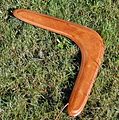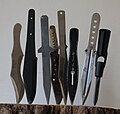Throwing weapon
Throwing weapon is a collective term for simple forms of long-range or long-range weapons, which are thrown using muscle power . The term handgun is more precise, but is rarely used. Other long-range weapons such as catapults , grenade , charge or rocket launchers are not included.
Application, effect, materials
The term throwing weapon includes all weapons whose purpose is to be thrown by hand. In order to use these weapons specifically for hunting and combat , the user must be familiar with their properties and have a minimum of practice with the weapon.
Depending on various factors such as material or shape, the thrown weapons are thrown or thrown straight or rotating and thus each have a different flight behavior. Throwing weapons without air control as in z. B. Stones or hand grenades tumble in the air. Air-controlled weapons are divided into:
- Stabilization over a suitable center of mass in relation to mass , buoyancy and air resistance : spear
- Control surface control with or without twist along the flight path: dart
- Stabilization via rotary axis transverse to the trajectory: litter timber , throwing ax , clays
The classification of the slingshot as a throwing weapon is inconsistent . It is often referred to as such, but sometimes also viewed as a separate category.
Throwing weapons, like cutting weapons, can have a splitting effect due to their sharpness, like stabbing weapons penetrate through their points or, like striking weapons, have a blunt effect due to their kinetic energy . Throwing weapons are a specialty and have a captivating effect, such as the bola . As with most weapons, mixed forms are possible. Some thrown weapons could also be used as a cutting or stabbing weapon; on the other hand, weapons that were not actually intended to be thrown (e.g. clubs , trident, etc.) could also be thrown over a short distance. Throwing weapons such as hand grenades or incendiary bottles do not work through their kinetic energy, but through the chemical charge.
Weapons such as spears, throwing ax or throwing disc naturally harbor the risk of being picked up by the opponent and used against the actual thrower. For this reason, the Roman spear ( pilum ), for example, is constructed in such a way that the iron tip bent or the connection to the wooden shaft broke.
history
Throwing weapons are among the oldest weapons in human history. The first and most primitive types of throwing weapons were stones and woods. Heavy stones have also long been a simple means for defenders of fortifications , which have thrown them from walls at the attackers below. It has also been observed in monkeys that they throw sticks or hard fruit down from trees at approaching predators. Stones and throwing sticks are used both for knocking down fruit that cannot be climbed and as a hunting weapon. Throwing woods are particularly suitable for hunting small wild animals such as birds. If the impact of a throwing stick is less than that of a spear, the hit zone of the rotating stick is significantly larger.
The throwing spear, the oldest specimen found (e.g. Schöninger spears ) is estimated to be around 400,000 years old, with its piercing effect also made it possible to kill larger game. In the Upper Palaeolithic , the power and range of the spear was further increased by the invention of the spear thrower. In ancient times the javelin (e.g. the Roman pilum) was ubiquitous as a military weapon. In the late Middle Ages, the spear is a throwing weapon in favor of the optimized for stabbing spear abandoned.
The sling can be detected from the Mesolithic ; it enabled a greater range when throwing stones, which was increased again by further improvements, the stick sling , in the Roman Empire . Their use declined in the Middle Ages.
Some axes and similar objects are considered to be thrown weapons. This applies in particular to the Franziska der Franken , the Tomahawk of the Indians and the African throwing iron . These weapons can be thrown, but the extent to which this actually happened is controversial. Iron was extremely valuable in Europe well into the Middle Ages, and in Africa well into the 20th century, so objects made of iron were protected and used sparingly.
Burning bottles and similar objects have been known since ancient times. The hand grenade , which has been known since modern times, is still in military use.
Sports
Several sports emerged from the use of hand weapons, including javelin and discus throwing .
gallery
Roman pilum
European throwing knife
literature
- Max Dreger: Dreger Weapons Collection: With an introduction to the systematics of weapons. Verlag Walter de Gruyter, 1926, ISBN 3-11-140167-7 . (online at: books.google.de )
- Kelly DeVries, Robert Douglas Smith: Medieval military technology. University of Toronto Press, 2012, ISBN 978-1-4426-0497-1 .
Individual evidence
- ↑ Gerhard Seifert: Technical terms of the edged weapons knowledge. German ABC of the European naked defensive weapons. (Cut, thrust, hit and hand thrown weapons). Verlag Seifert, 1981, p. 8 (online at: franckowiak.de ) ( Memento from January 2, 2014 in the Internet Archive )
- ^ Dreger: Dreger weapons collection. 1926, p. 42.
- ↑ Collective of authors: Castles and Fixed Places. Verlag Walter de Gruyter, 2008, ISBN 978-3-11-097269-6 , p. 185 (online at: books.google.de )
- ^ Dreger: Dreger weapons collection. 1926, p. 42.
- ^ Dreger: Dreger weapons collection. 1926, p. 40.
- ↑ Raffaele D'Amato: Arms and Armor of the Imperial Roman Soldier: From Marius to Commodus, 112 BC-AD 192. Frontline Books, London, 2009, ISBN 978-1-84832-512-8 , p. 6.
- ^ Dreger: Dreger weapons collection. 1926, p. 40.
- ↑ DeVries, Smith: Medieval military technology. 2012, pp. 2–3.
- ↑ DeVries, Smith: Medieval military technology. 2012, p. 14.
- ↑ DeVries, Smith: Medieval military technology. 2012, pp. 2–3.
- ↑ DeVries, Smith: Medieval military technology. 2012, p. 34.
- ^ Dreger: Dreger weapons collection. 1926, pp. 39-40.
- Jump up ↑ Patrick J. Geary : The Merovingians: Europe before Charlemagne. Verlag CH Beck, 2003, ISBN 3-406-49426-9 , pp. 58 and 103. (online at: books.google.de )
- ↑ Marc Leopold Felix : Kipinga: throwing-blades of central Africa. Verlag F. Jahn, 1991, p. 38.









